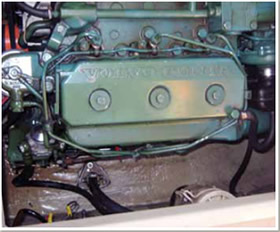
The LM32 construction is conventional but well done, and the boat lives up to its reputation for high-quality and fine craftsmanship.
Hull: The hull above and below the waterline is hand-laminated fiberglass-alternating layers of mat and roving. The interior is stick-built. Bulkheads, shelves, and floor stringers are laminated to the hull to add strength.
Deck: The deck is constructed of single-unit, hand-laminated fiberglass with balsa core for stiffness, and marine mahogany plywood in lieu of balsa in high-stress areas. The deck should be professionally inspected for signs of water damage or rot.
Hull-to-deck joint: Decks are fastened to the hull with an unusual flange that extends downward from the molded toerail and is attached to the hull with screws beneath a rubrail; inside, the joint is glassed over.
Rudder and keel: The spade rudder is supported by a partial skeg. Cable-steering systems should get annual inspection. The ballast keel-an alloy of lead and iron, according to the maker-is cast in fiberglass and glassed in place.
Rig: The rig is a conventional, single-spreader masthead sloop. We could find no brand name or manufacturer on the spars, but they appear well made with quality fittings. The mast is deck-stepped, with the saloon bulkhead and wood compression post providing the under-deck support. The upper and lower shrouds attach to chainplates, which are close to the deckhouse, making sidedecks adequately wide except at the back edge of the pilothouse. A tabernacle/fold-down mast was an option, but we don’t think any were imported to the U.S.






































